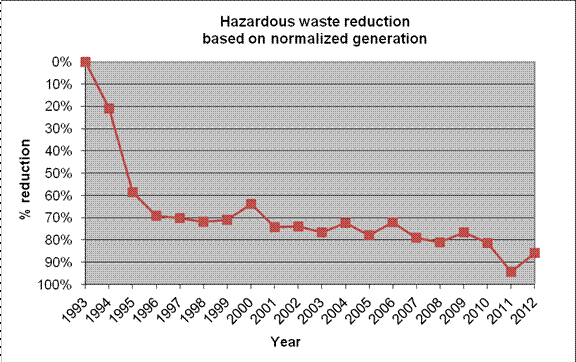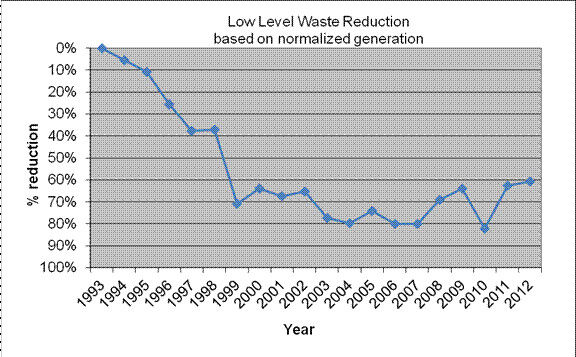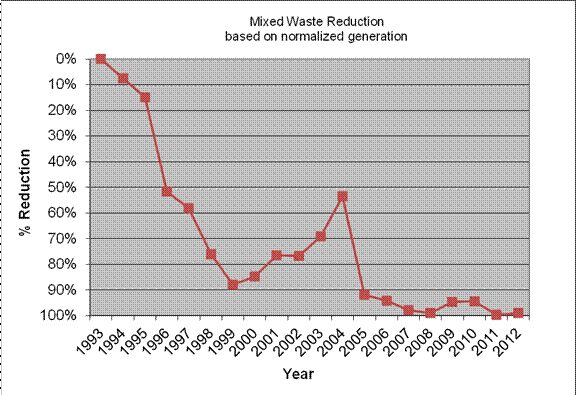Hazardous Waste
Hazardous Waste
The goal of the Berkeley Lab is to avoid the generation of hazardous waste to the extent possible. Each year, Berkeley Lab reviews hazardous waste generating processes to look for waste avoidance or minimization opportunities. The graph below shows the result of these efforts. Many of the reductions are due to implementing microscale processes and product substitution.
The graph below represents the accomplishments of the research and operating staff at the Berkeley Lab to reduce the amount of hazardous wastes as a result of their activities. These figures are normalized to present a comparable picture from year to year. The quantity of hazardous waste generated:
- includes the volumes of mixed wastes that will decay and exit regulation as radioactive waste,
- includes the volume of scintillation vials that meet the Nuclear Regulatory Commission (NRC) criteria for disposal as non-radioactive waste.
- excludes non-routinely generated hazardous waste.

Nonroutine Hazardous Waste
The Berkeley Lab has more than 100 separate structures, some of which are over fifty years old. The renovation of buildings and other infrastructure to comply with new laws and to accommodate new research directions is a high priority at the Lab. Site renovation activities have included the removal or replacement of single walled underground storage tanks with environmentally safe double walled tanks, the renovation of many cooling towers, the reengineering of the main photographic shop to fully electronic (non-chemical) technologies, and the decommissioning of the Bevatron and Hilac accelerators to name a few. To the extent possible, deconstruction wastes are diverted from the landfill if there are reuse or recycling opportunities.
[Back to top]
Low Level Waste
Low-Level Waste
The goal of the Berkeley Lab is to avoid the generation of radioactive waste to the extent possible and minimize radioactive waste where practical. Each year Berkeley Lab reviews generating processes to look for waste avoidance or minimization opportunities. These may include product substitution, microscale experiments, and implementation of appropriate technology.
The graph below represents the accomplishments of the research and operating staff at the Berkeley Lab to reduce the amount of low level waste as a result of research and operations. These figures are normalized to present a comparable picture from year to year. The quantity of radioactive waste generated:
- includes the volumes of low level waste from the neutralization of mixed waste,
- excludes the volumes of low level waste that will decay and exit regulation as radioactive waste,
- excludes the volume of scintillation vials that meet the Nuclear Regulatory Commission (NRC) criteria for disposal as non-radioactive waste. Note: this volume is added to the volume of hazardous waste.
- Excludes non-routinely generated low level waste.

Nonroutine low level radioactive wastes include legacy wastes generated during past operations, or other one-time wastes generated during renovation, decommissioning, construction, demolition, or site restoration activities.
[Back to top]
Mixed Waste
Mixed Waste
The goal of the Berkeley Lab is to avoid the generation of mixed waste to the extent possible and minimize mixed waste where practical. Each year Berkeley Lab reviews generating processes to look for waste avoidance or minimization opportunities. These may include product substitution, microscale experiments, and implementation of appropriate technology.
The graph below represents the accomplishments of the research and operating staff at the Berkeley Lab to reduce the amount of mixed waste as a result of their activities. These figures are normalized to present a comparable picture from year to year. The quantity of mixed waste generated:
- excludes volumes of mixed waste subject to the decay in place program (this volume is added to the volume of hazardous waste)
- excludes volumes of mixed waste that will be neutralized (this volume is added to the volume of low level waste),
- excludes non-routinely generated mixed waste.

Because Berkeley Lab began tracking routine mixed waste generation in 1994, the 1993
baseline is linearly extrapolated from 1994 and 1995 data.
The drastic reduction from 2004 to 2005 was the result of eliminating the use of certain lots of Ultima Gold scintillation fluid from routine use. Certain lots were found to have regulated levels of 1,2 dichloroethane that resulted in mixed waste when used to analyze radioactive material samples.
In general, non routine mixed wastes include legacy wastes generated during past operations, or other one-time wastes generated during renovation, decommissioning, construction, demolition or site restoration activities.
[Back to top]
Programs and Requirements
Programs and Requirements
Pollution Prevention
The Berkeley Lab waste minimization efforts are focused at the research program level. To promote pollution prevention, each Division is required to identify 1-2 waste generating processes for review or waste minimization projects per year. The process reviews are documented and, if appropriate, the minimization opportunity implemented. These reviews occasionally result in return on investment (ROI) proposals that are submitted for funding either to the Division or via the Laboratory’s internal funding mechanism. Divisions are encouraged to incorporate these waste minimization reviews into their existing peer and safety reviews for new projects as well.
The waste minimization projects are reviewed for possible inclusion as part of the Environmental Management System (EMS) review.
As a government owned facility operated through contract by the University of California, Berkeley Lab must comply with waste minimization reporting requirements issued by the Department of Energy (DOE) and the State of California.
DOE Requirements include:
Environmental Management System (EMS) – Executive Order 13148, Greening the Government through Leadership in Environmental Management required all federal agencies to implement an Environmental Management System (EMS) by December 31, 2005. An EMS is a systematic approach to achieve environmental goals. DOE Order 450.1, Environmental Protection Program, established the EMS requirement for all DOE facilities and, in addition, mandated that the EMS be integrated with existing Integrated Safety Management systems. More information on EMS can be found at https://commons.lbl.gov/display/sustainlbl/Environmental+Management+System
Reporting Requirements
The Pollution Prevention Annual Report includes the Laboratory’s waste generation and recycled quantities for sanitary wastes and generated quantities of hazardous, radioactive, and mixed wastes. The quantities are not normalized for budget growth or decline as are the quantities represented in the pages of this web site.
California Senate Bill 14 (SB-14) requires Berkeley Lab to report on its progress in minimizing its hazardous wastes every four years and to formulate plans for the further minimization of hazardous wastes streams that exceed 5% of the total hazardous or extremely hazardous waste for the year preceding the report. The last SB-14 report was submitted in August 2003 in conjunction with other California DOE sites.
[Back to top]
Waste Minimization Hints
As a generator of waste at the Berkeley Lab, you must develop and implement waste minimization in your research or support areas. Divisions are encouraged to review waste generating processes prior to the waste being generated and periodically thereafter. Berkeley Lab maintains a successful waste minimization program.The following list highlights a few of the things you can do to minimize your waste.
Separation and Segregation
- Avoid cross contamination by storing radioactive waste separately from hazardous and nonhazardous wastes and other nonradioactive materials.
- Segregate your liquid radioactive waste based on isotopic half life.
- Scintillation vials showing no activity above background should be accumulated separately and managed as nonradioactive waste.
- Segregate non hazardous materials from hazardous materials or wastes.
Good Housekeeping
- Keep accumulation of wastes in your SAA to a minimum by requesting frequent waste pickups. This can reduce the potential for generation of spill clean-up wastes in the event of an upset condition (such as an earthquake).
- Label and note contents on all in-use containers such as beakers, flasks or tubes, whether hazardous or not, to reduce the potential for generation of unknown waste mixtures.
Material Recycle and Reuse
- Reuse gel staining or destaining solutions.
- Reuse spent solvents for initial rinses or general cleaning.
- Reuse cleaning solutions when practical.
Material Substitution
- Substitute nonhazardous chemicals whenever possible.
- Substitute red liquid (alcohol) thermometers or digital thermometers for mercury thermometers where practicable.
- Substitute biodegradable nontoxic detergents for cleaning solvents.
- To the extent possible use isotopes with half-lives shorter than 90 days.
- Search for and use nonradioactive substitutes (e.g. immunoassay reagents, materials labeled with stable isotopes or other nonradioactive tracers), particularly when the use of long-lived isotopes is desired.
Process Modification
- Design your experiments to use the minimum amount of hazardous or radioactive material (i.e. microscale chemistry).
- Implement benchtop treatment whenever possible (contact your Generator Assistant for details)
- Keep 3H and 14C activities in animal tissues and scintillation fluids below 0.05 microcuries/gram whenever possible.
Inventory and Purchasing Controls
- Order only the amount of radioactive materials and chemicals you will use in a reasonable period of time. Centralize purchasing in your laboratory if possible to minimize duplicate orders.
- When practical, reassign chemicals to another owner for use rather than disposal.
For more details on any of these suggestions, or for assistance in waste minimization, please contact your Environmental Management Representative.

